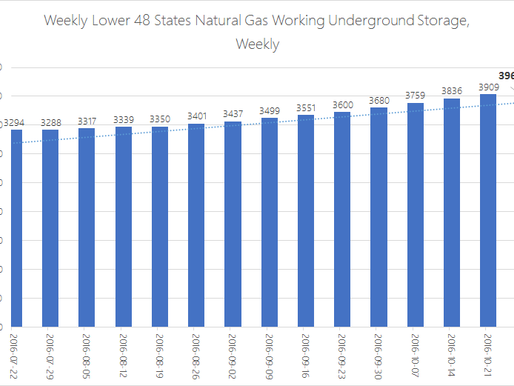top of page


MARKET INTELLIGENCE & INDUSTRY NEWS
Search


EIA Natural Gas Storage Report 11-10-16
Leading up to todays report, Natural gas halted its downward slide Wednesday as market participants awaited new data on supplies and more...
Nov 10, 20161 min read


EIA's Weekly Crude Inventory Report 11-09-16
WTI crude oil remained lower, marginally paring back on some pre-inventory losses following the report from the government. The EIA...
Nov 9, 20163 min read


EIA Natural Gas Storage Report 11-03-16
Leading up to today's EIA Natural Gas Storage report, Natural gas prices fell sharply once again in yesterday’s trading, with the...
Nov 3, 20162 min read


EIA's Weekly Crude Inventory Report 11-02-16
WTI crude oil slightly pared back on this morning’s steep losses despite the EIA’s inventory report which showed a substantially larger...
Nov 2, 20162 min read


EIA Natural Gas Storage Report 10-27-16
Leading up to today's EIA Natural Gas Storage report, Natural gas wholesale contracts fell to a fresh seven-week low on Wednesday, as...
Oct 27, 20162 min read


EIA's Weekly Crude Inventory Report 10-26-16
WTI crude oil futures pared back on this morning’s steep losses following the positive inventory from the government that showed crude...
Oct 26, 20162 min read


EIA Natural Gas Storage Report 10-20-16
Leading up to today's EIA Natural Gas Storage report, Natural gas prices rallied a little higher as natural gas traders were attempting...
Oct 20, 20162 min read


EIA's Weekly Crude Inventory Report 10-19-16
WTI crude oil futures built onto this morning’s strong gains after the EIA confirmed a draw that was initially reported by the API last...
Oct 19, 20162 min read


EIA Natural Gas Storage Report 10-13-16
Leading up to today's EIA Natural Gas Storage report, Natural gas prices retreated for a second-straight session on Wednesday, with...
Oct 13, 20162 min read


EIA's Weekly Crude Inventory Report 10-13-16
WTI crude oil futures gave back some of the light gains that were seen ahead of the inventory as crude inventories added more to storage...
Oct 13, 20162 min read


Winter heating bills likely to increase, but still remain below recent winters
Most U.S. households can expect higher heating expenditures this winter (October through March) compared to last winter, according to...
Oct 12, 20162 min read


Energy-related CO2 emissions for first six months of 2016 are lowest since 1991
U.S. energy-related carbon dioxide (CO2) emissions totaled 2,530 million metric tons in the first six months of 2016. This was the lowest...
Oct 10, 20162 min read


EIA Natural Gas Storage Report 10-6-16
Leading up to today's EIA Natural Gas Storage report, Natural-gas prices ticked higher Tuesday afternoon, rebounding from early morning...
Oct 6, 20162 min read


EIA's Weekly Crude Inventory Report 10-5-16
WTI crude oil futures added lightly to the gains from this morning following the government’s inventory report which revealed mixed...
Oct 5, 20162 min read


EIA Natural Gas Storage Report 9-29-16
Leading up to today's EIA Natural Gas Storage report, Natural gas wholesale contracts wobbled below the highest level since January 2015...
Sep 29, 20162 min read


EIA's Weekly Crude Inventory Report 9-28-16
WTI crude oil futures added lightly to the gains from this morning following the government’s inventory report which revealed mixed...
Sep 29, 20162 min read


Hydrocarbon production in the Utica play increasingly targets natural gas-rich areas
Production of oil and natural gas in the Appalachian Basin's Utica play—which includes both the Utica and Point Pleasant formations—has...
Sep 26, 20163 min read


EIA Natural Gas Storage Report 9-22-16
Leading up to today's EIA Natural Gas Storage report, Natural gas wholesale contracts rose to a new 16-month high for the second day in a...
Sep 22, 20162 min read


EIA's Weekly Crude Inventory Report 9-21-16
WTI crude oil futures tacked onto earlier gains following the inventory report from the EIA which confirmed the substantial decrease from...
Sep 21, 20162 min read


Why the Oil Rig Count Could Impact Natural Gas
Natural gas rigs On September 2, 2016, the natural gas (UNG) (FCG) (BOIL) (GASL) (GASX) (UGAZ) (DGAZ) rig count was 88—seven more than...
Sep 16, 20162 min read
bottom of page